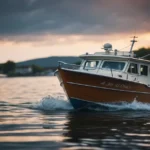Set sail into the new year with my Article “Yard Sailing – Your Great Guide,” where we navigate the ins and outs of mastering the seas with your trusty yardarm. Whether you’re a seasoned sailor or just getting your sea legs, this guide is the perfect compass for sailing.
Prepare to hoist the sails and embark on an exhilarating journey that promises fresh breezes and unforgettable horizons regarding Yard Sailing!
Understanding Yard and Sails
Yards are horizontal spars attached to a mast that support and spread the sails. Understanding the relationship between these elements is pivotal in yard sailing. To clarify, a sail is a broad piece of fabric or other material that harnesses the wind‘s power to propel a vessel on the water.
Various types of sails exist, such as triangular sails, like those seen on a Bermuda rig, or square sails, more commonly found on tall ships or square-rigged vessels.
- Square sails are attached to the yardarms (the ends of the yard) and require a different handling technique than triangular sails.
- Triangular sails, on the other hand, are controlled directly by sheets and halyards—lines responsible for adjusting the angle and position.
- Sails may be constructed from various materials, including canvas, polyester, or, in modern cases, carbon fiber, for better durability and efficiency.
Rigging and Its Components
The rigging of a ship involves numerous components, each with its distinct function. Rigging generally refers to ropes, wires, or chains that support a ship’s masts – the vertical poles – and control the sails.
- Shrouds and stays are types of rigging that enhance the stability of the mast.
- Braces pivot the yards around the mast, allowing sailors to adjust their sails to the optimal direction relative to the wind.
- The halyard is a line employed to hoist or lower the sails. It is pivotal in maneuvers such as setting sail or reefing, reducing the sail area in strong wind conditions.
Yard sailing demands a firm grasp of these terms and their physical components and an understanding of how each element works in harmony to enable a ship to sail effectively. It’s a testament to seamanship and the ability to finely tune the interactions between wind, sail, and vessel to achieve controlled, purposeful motion at sea.
Sailing Dynamics and Techniques

Exploring the dynamics of yard sailing has significantly changed my understanding of maneuvering a ship. I’ve realized it’s a blend of art and science where mastery over sail control and navigational strategies is critical to harnessing the power of the wind.
Mastering Sail Control
My experiences have taught me that sail control is fundamental for optimizing a sailboat’s performance. Balancing the boat becomes crucial when managing the sails to capture the wind effectively. I constantly adjust the sheets – the ropes that control the angle of the sails – and pay close attention to the clewlines, which help shape the sails.
In heavier weather, reefing or reducing the sail area is critical for maintaining control and safety. I’ve found that using safety wires and gaskets ready for fastening is essential for quick sail adjustments, especially when I need to reduce speed or wind exposure.
Navigational Strategies
When it comes to sailing, understanding wind direction and making strategic moves like tacking and turning the bow through the wind is what sailing is all about for me. It’s about the ship cutting through the water, steadily progressing towards my course. I use the wind’s lifts, or shifts in direction, to my advantage by adjusting the sails accordingly. I often handle the tye chain or the rope to change the yard’s position when going aloft or employing flemish horse and footropes for balance and safety.
Participating in tall ship’ races requires precise movement and speed. The familiar sight of the sun over the yardarm signals a strategic moment to assess progress and make necessary adjustments. I always keep an eye on the head of the sail and maintain a keen sense of the quarters of the wind for optimized sailing.
FAQ – Yard Sailing

I’ve noticed that folks new to the sailing world tend to have a few common questions about the basics. Specifically, they’re curious about Yard Sailing. Let’s unpack these questions one by one.
What is a yard in sailing terms?
In sailing, a yard is a horizontal spar typically made of wood, metal, or modern materials like aluminum or carbon fiber. It’s an essential part of the ship’s rigging, supporting and spreading a sail, enabling it to catch the wind efficiently.
How is a yard connected to a mast?
The yard is connected to the mast via a system that allows for a secure attachment and the necessary movement. The yardarm, which is the outer part of the yard, may pivot or lift to adjust the sails to the direction of the wind for optimal sailing.
What does yard mean in terms of ships?
For ships, the yard signifies the spar on which sails are set. It is a functional piece of equipment and a critical aspect of naval terminology. On sailing vessels, yards are essential for handling and manipulating sails to achieve desired sailing conditions.
Drop anchor in the comments below and share your Yard Sailing tales or tips—we’re all crew members here eager to learn from your experiences!










